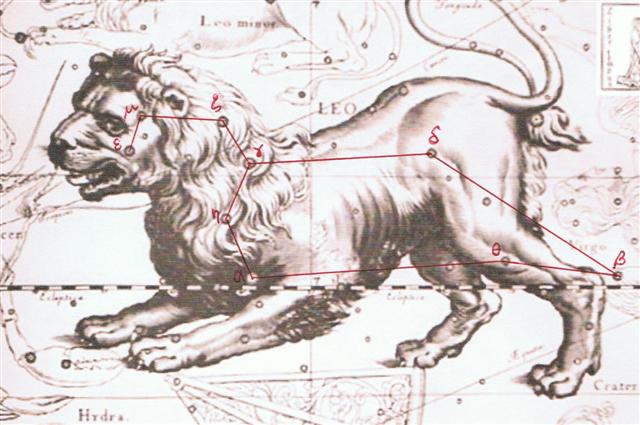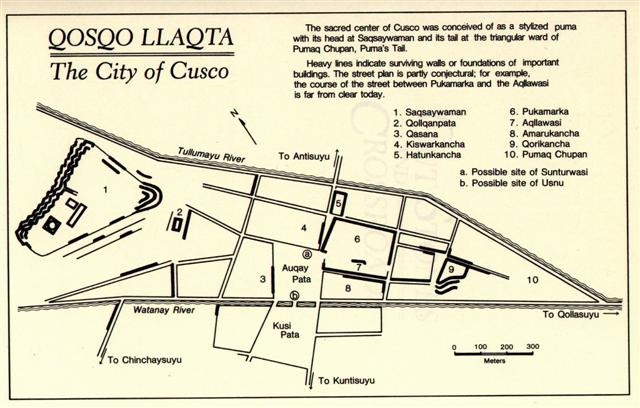Furthermore,
the
down sloping
path
of
the
ecliptic
at
this
place was
in
harmony
with
rain
and
water
moving
downwards
towards
the
Abyss.
The
Chorti
began
their
sky
raising
ceremonies
in
ºApril
25
(115)
and
120
days
later
was
ºSeptember
2
(245),
when
the
sky
roof
definitely no
longer
could
be
pushed
any higher:
| JULY 2 |
3 (184) |
4 (*105) |
 |
 |
 |
| Ga4-20 |
Ga4-21 (104) |
Ga4-22 |
| 11h (167.4) |
AL SHARAS = β Crateris (168.6) |
Al Zubrah-9 / Purva Phalguni-11 |
| χ Leonis, χ¹ Hydrae (167.1), χ² Hydrae (167.3) |
ZOSMA = δ Leonis (169.2), COXA = θ Leonis (169.4) |
| September 4 |
5 (248 = 104 + 144) |
6 |
| °August 31 |
°September 1 (244) |
2 |
| 'August 8 (*140) |
9 |
10 (222) |
| "July 25 (*126) |
26 |
27 (208) |
| NAKSHATRA DATES: |
| JANUARY 1 |
2 |
3 (368) |
| 23h (350.0) |
SIMMAH = γ Piscium (351.7) |
φ Aquarii (352.0), ψ Aquarii (352.4), χ Aquarii (352.6), γ Tucanae, φ Gruis (352.8) |
| υ, θ Gruis (350.0), π Cephei (350.6), ι Gruis (350.9) |
| March 6 (*350) |
7 (66) |
8 (432) |
| °March 2 (*346) |
3 |
4 (63) |
| 'February 7 |
8 (*324) |
9 (40) |
| "January 24 |
25 (*310) |
26 |
| JULY 5 |
6 (*107) |
7 |
8 |
9 (190) |
 |
 |
 |
 |
 |
| Ga4-23 |
Ga4-24 |
Ga4-25 (108) |
Ga4-26 |
Ga4-27 |
| φ Leonis (170.0), ALULA = ξ, ν Ursae Majoris (170.5), LABRUM = δ Crateris (170.6) |
σ Leonis (171.1), λ Crateris (171.6), ι Leonis, ε Crateris (171.9) |
γ Crateris, π Centauri (172.0), κ Crateris (172.5), τ Leonis (172.8) GREDI (α Capricorni)
|
ο¹ Centauri (173.8) |
GIAUZAR = λ Draconis (174.0), ξ Hydrae (174.3), ο² Centauri, λ Centauri (174.8) |
| September 7 |
8 |
9 (*172) |
10 |
11 (254) |
| °September 3 |
4 |
5 (*168) |
6 |
7 (250) |
| 'August 11 |
12 (*144) |
13 |
14 |
15 (227) |
| "July 28 |
29 (*130) |
30 |
31 (212) |
"August 1 |
| NAKSHATRA DATES: |
| JANUARY 4 |
5 (*290) |
6 |
7 (372) |
8 |
| CROSS-BARS |
ο Gruis, Snowball Nebula = NGC7662 Andromedae (355.0), τ Oct. (355.3) |
no star listed (356) |
ι Phoenicis (357.3), ι Piscium (357.4), λ Andromedae (357.9) |
| ο Cephei (353.3), KERB = τ Pegasi (353.6) |
κ Piscium (354.2), θ Piscium (354.4), υ Pegasi (354.9) |
| March 9 |
10 (*354) |
11 |
12 |
13 (72) |
| °March 5 |
6 (*350) |
7 |
8 |
9 (68) |
| 'February 10 (41) |
11 |
12 |
13 (*329) |
2-14 |
| "January 27 |
28 (393) |
29 (*314) |
30 |
31 |
The
pair
of
mama
glyphs
(Ga4-23--24)
could
well be
illustrating
a
pair
of
canoe
hulls
in
the
night,
launched
because
the
Sun
had
reached
Zosma
and
Coxa:


... the first month of the Moriori year, was named Rongo (Lono). On the first of the new year the Moriori launched a small canoe to Rongo, although they built and used only rude craft for their fishing excursions. The canoe was manned by twelve figures symbolizing the personifications of the twelve months. Sometimes twenty-four figures were placed in the canoe, and Skinner interprets the additional twelve as representing the female counterparts of the months. As an old Maori once remarked. 'Everything has its female counterpart.'
... A curious diversion appears in the month list of the people of Porapora and Moorea in the Society Islands, which sheds light on the custom of the Moriori who sometimes placed 24 figures in the canoe which they dispatched seaward to the god Rongo on new years day. The names of the wives of the months are included, indicating that other Polynesians besides the Chatham Islanders personified the months ... (Makemson)
According to Manuscript E the canoe of Hotu Matua sailed from Maori in the 2nd day of Hora Nui. Should we translate Hora Nui 2 with ºSeptember 2 (245) - at heliacal Zosma and Coxa - then he ought to have arrived in ºOctober 15 (288) when the Sun reached Thuban and when Hamal was at the Full Moon:
|
AUGUST 14 |
15 |
16 (*148) |
17 (229) |
18 |
19 |
 |
 |
 |
 |
 |
 |
|
Ga6-6 |
Ga6-7 |
Ga6-8 (148) |
Ga6-9 |
Ga6-10 |
Ga6-11 |
|
MUPHRID = η Bootis
(210.1), ζ Centauri (210.3) |
φ Centauri (211.0), υ¹ Centauri (211.1),
υ² Centauri (211.8), τ Virginis (211.9) |
AGENA = β Centauri
(212.1), θ Apodis (212.5),
THUBAN
= α Draconis
(212.8) |
14h (213.1) |
Neck-2 |
Al Ghafr-13 /
Svāti-15 /
TAHUA-TAATA-METUA-TE-TUPU-MAVAE-6
(a pillar to stand by) |
|
π Hydrae, χ Centauri (213.0),
MENKENT = θ Centauri
(213.1) |
ASELLUS TERTIUS = κ Bootis,
κ Virginis,
14 Bootis
(214.8) |
15 Bootis
(215.2),
ARCTURUS
= α Bootis
(215.4),
ASELLUS SECUNDUS = ι Bootis
(215.5),
SYRMA = ι Virginis,
λ Bootis (215.6), η Apodis (215.8) |
|
October 17 (290) |
18 |
19 |
20 |
21 (*214) |
22 |
|
°October 13 |
14 |
15 (*208) |
16 |
17 (290) |
18 |
|
'September 20 |
21 |
EQUINOX |
23 (*186) |
24 |
25 (268) |
|
"September 6 |
7 |
8 |
9 (*172) |
10 |
11 (254) |
|
NAKSHATRA DATES: |
|
FEBRUARY 13 |
2-14 (45) |
15 |
16 (*332) |
17 (413) |
18 |
|
ι Arietis
(28.0), λ Arietis (28.2), υ Ceti (28.8) |
ALRISHA
= α Piscium, χ Phoenicis
(29.2),
ALAMAK = γ Andromedae
(29.7) |
Arku-sha-rishu-ku-2 (Back of the
Head of Ku) |
η Arietis
(31.9) |
ξ¹ Ceti
(32.1) |
χ Persei
(33.2), θ Arietis (33.3),
MIRA = ο Ceti
(33.7) |
|
2h (30.4) |
|
κ Arietis
(30.3),
HAMAL
= α Arietis
(30.5)
ALKES (α
Crateris)
|
|
April 18
(473) |
19 |
20 (*395) |
21 (111) |
22 |
23 |
|
4-14 |
°April 15 |
16 (471) |
17 (107) |
18 |
19 |
|
'March 22 |
23 |
24 (*368) |
EQUINOX |
26 (85) |
27 |
|
"March 8 |
9 |
10 (*354) |
11 |
12 |
13 |
Possibly one set of dates could have been used for events north of the equator, viz. according to the Gregorian calendar, and another calendar for events south of the equator in Polynesia, for instance according to the stars in the nakshatra night when Bharani was at 0h. In the north they counted with days but in Polynesia they counted with nights (po). Hiva for the latter time frame and Maori for the time frame of the Gregorian calendar?
| Maori Wise teacher; tagata maori rogorogo, person who can recite the signs of the tablets; maori hare, house builder; maori îka, healer expert in treating fight injuries. Name of the country of origin of Hotu Matu'a which he fled with his people following a cataclysm in a land called Hiva. Vanaga.
a. Of manual training: dexterity, handy, industry, artisan. b. Of mental training: erudite, finesse, cleverness, adroit, ingenious, intelligent, lucid, sage, sense, science, talent. c. The resultant: memorable, renowned, of good reputation. Tagata maori, carpenter; rima maori, left hand, tae maori, incompetent; maori ke, judicious, sly; maori ke avai, adroit. T Pau.: maori, maohi, indigenous, sure, safe, perfect. Mgv.; maori, belonging to the country, native of the Polynesian race, right hand. Mq.: maoi, native, natural, common, ordinary. Ta.: maori, maóhi, proper name of the indigenous people of Polynesia, native, good, perfect. Churchill. |
| Hiva Name of the country from where, according to tradition, came the Polynesian immigration of Hotu Matu'a; nowadays, this name designates any continent or foreign country: tagata Hiva, foreigner, person from the mainland. Vanaga.
Strange, alien, foreign; a stranger; kuhane hiva, Holy Ghost; hakahiva: mata hakahiva, to look back (? hakahira). Mq., Mgv.: hiva, iva, a stranger, a person from another district or country. Pau.: pure-hiva, a butterfly. Churchill.
H.: 1. Entirely black, as of pigs offered to the gods, a desirable blackness contrasting with uli and 'ele'ele, which have pejorative connotations. 2. Choice. 3. A term qualifying coconuts and kava. Polo hiwa, dark, glistening black, as clouds or tapa. Ua hala i ke ao polohiwa a Kāne, passed to the dark clouds of Kāne (death). Hiwa hiwa, precious, beloved, esteemed, petted, darling, indulged; favorite. Ka Mesia, ka hiwahiwa a ke Akua, the Messiah, the chosen of God. Ho'o hiwa hiwa to honor, adorn, decorate; to display, as the flag; to treat as a favorite; festive. He mea ho'ohiwahiwa i ke akua, a thing to honor the gods. 'O ka mea ho'ohiwahiwa i kāna kauā mai kona wā 'u'uku mai, he who delicately brings up his servant from his childhood. Wehewehe. |
| Po 1. Night; to get dark, to fall (of night): he-po, it is getting dark. Formerly used, with or without raá, in the meaning of a whole day: po tahi, one day; katahi te kauatu marima po, fifteen days; po tahi raá, first day of the week; po rua raá, po toru raá, second, third day, etc. 2. Alone or as po nui, used to express the idea of good luck, happiness. He-avai-atu au to'ou po, I wish you good luck (when taking leave of someone). Very common was this parting formula: aná po noho ki a koe! good luck to you! Po-á, morning; i te po-á, in the morning; i te po-era-á, very early in the morning. Po-ará, quickly, rapidly, swiftly: he-iri po-ará, go up quick; he-ta'o itau umu era po-ará, he cooked it quickly. Po-e-mahina, formerly used of sleep-walkers (haha a po). Vanaga.
1. Darkness, night, late; po haha, dark night, gloom. P Tu. po-tagotago, darkness. Mgv., Mq., Ta.: po, darkness, night. 2. Calendar day; po e rua, Tuesday; po o te tagata, life. P Pau., Mgv., Mq., Ta.: po, calendar day. Churchill. |
If so, then the distance across the Sea (the domain of the fishes - cfr Ga4-21) could have been measured out as 43 nights, viz. from ºSeptember 2 (245) to "October 15 (288), from heliacal Zosma and Coxa to nakshatra Antares:
| JULY 3 (184) |
4 |
40 |
0h |
MARCH 22 (*1) |
23 (82) |
 |
 |
no glyph |
 |
 |
| Ga4-21 (104) |
Ga4-22 |
Ga1-1 |
Ga1-2 |
| AL SHARAS (*168) |
ZOSMA, COXA |
HYADUM II |
AIN |
(146 = 2 * 73) |
| σ Scorpii (*247) |
ANTARES |
| °September 1 (244) |
2 (*165) |
°May 20 (140) |
21 (*61) |
22 |
| "July 26 (*127) |
27 |
4-13 |
"April 14 (104) |
15 |
| "January 25 (*310) |
Tuaharo 26 |
"October 13 (286) |
Tagaroa Uri 14 |
15 (*208) |
| September 5 (104 + 144) |
43 = 288 - 245 (= 227 - 184) |
But nothing can be certain in this labyrinth of dates. ... Space and time are a single, related concept in Runasimi [the language of the Inca people], represented by one word, pacha, which can also mean 'world' and 'universe'. The image of time familiar to Waman Puma was static and spatial: one could travel in time as one travels over earth - the structure, the geography, remaining unchanged. To him it does not matter that he shows Inka Wayna Qhapaq, who died in 1525, talking to Spaniard, who did not arrive until 1532. Wayna Qhapaq was the last Inca to rule an undivided empire: he is therefore the archetype, and it must be he who asks the Spaniards. 'Do you eat gold?'
In Andean thought both world and time were divided into four sectors or directions unified under a presiding fifth principle. The Tawantinsuyu - 'the indivisible four quarters' - was unified and presided over by Cusco, the center. Similarly, history was divided into four previous ages, presided over by a fifth, the present. In his book, Waman Puma organizes the history of both Old and New worlds according to this scheme. The Old Testament and the pre-Inca times are each divided into four equivalent and parallel ages. The 'present' age in Peru begins with the appearance of Manku Qhapaq, the first Inca, a being of supernatural origin. And in the Old World the 'present' starts with the birth of Jesus Christ ... (The Two Worlds of Peru)

|











